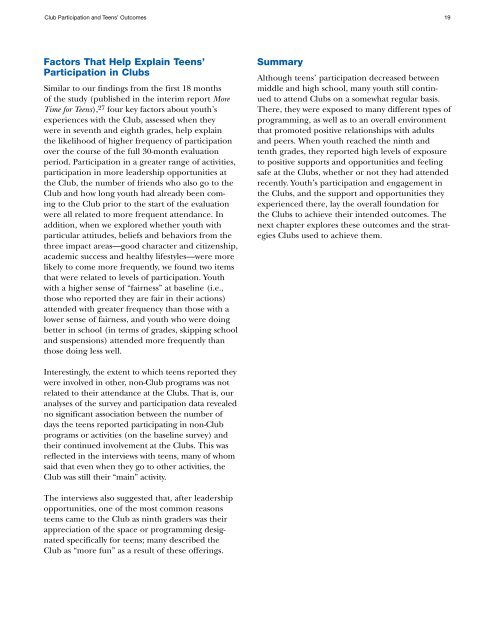Making Every Day Count - Teens
Making Every Day Count - Teens
Making Every Day Count - Teens
You also want an ePaper? Increase the reach of your titles
YUMPU automatically turns print PDFs into web optimized ePapers that Google loves.
Club Participation and <strong>Teens</strong>’ Outcomes 19Factors That Help Explain <strong>Teens</strong>’Participation in ClubsSimilar to our findings from the first 18 monthsof the study (published in the interim report MoreTime for <strong>Teens</strong>), 27 four key factors about youth’sexperiences with the Club, assessed when theywere in seventh and eighth grades, help explainthe likelihood of higher frequency of participationover the course of the full 30-month evaluationperiod. Participation in a greater range of activities,participation in more leadership opportunities atthe Club, the number of friends who also go to theClub and how long youth had already been comingto the Club prior to the start of the evaluationwere all related to more frequent attendance. Inaddition, when we explored whether youth withparticular attitudes, beliefs and behaviors from thethree impact areas—good character and citizenship,academic success and healthy lifestyles—were morelikely to come more frequently, we found two itemsthat were related to levels of participation. Youthwith a higher sense of “fairness” at baseline (i.e.,those who reported they are fair in their actions)attended with greater frequency than those with alower sense of fairness, and youth who were doingbetter in school (in terms of grades, skipping schooland suspensions) attended more frequently thanthose doing less well.SummaryAlthough teens’ participation decreased betweenmiddle and high school, many youth still continuedto attend Clubs on a somewhat regular basis.There, they were exposed to many different types ofprogramming, as well as to an overall environmentthat promoted positive relationships with adultsand peers. When youth reached the ninth andtenth grades, they reported high levels of exposureto positive supports and opportunities and feelingsafe at the Clubs, whether or not they had attendedrecently. Youth’s participation and engagement inthe Clubs, and the support and opportunities theyexperienced there, lay the overall foundation forthe Clubs to achieve their intended outcomes. Thenext chapter explores these outcomes and the strategiesClubs used to achieve them.Interestingly, the extent to which teens reported theywere involved in other, non-Club programs was notrelated to their attendance at the Clubs. That is, ouranalyses of the survey and participation data revealedno significant association between the number ofdays the teens reported participating in non-Clubprograms or activities (on the baseline survey) andtheir continued involvement at the Clubs. This wasreflected in the interviews with teens, many of whomsaid that even when they go to other activities, theClub was still their “main” activity.The interviews also suggested that, after leadershipopportunities, one of the most common reasonsteens came to the Club as ninth graders was theirappreciation of the space or programming designatedspecifically for teens; many described theClub as “more fun” as a result of these offerings.


